Five principles for successfully managing managers
Why skip leads are the load-bearing pillars of your organization
👋 Welcome to a ✨ free monthly edition ✨ of my weekly newsletter. Each week I tackle reader questions about building product, driving growth, and accelerating your career. For more: Lenny’s Podcast | How I AI | Lennybot | Lenny’s Reads | Courses | Swag
If you aren’t a paid subscriber, here’s what you missed this month:
Annual subscribers also get a free year of Perplexity Pro, Notion, Superhuman, Linear, Granola, and more. Subscribe now.
Saumil Mehta is the former CPO and Head of Business for Square. He most recently ran Product Management, Marketing, and Partnerships across Square while reporting to the CEO. Over a nine-year tenure, he also held various General Manager roles with full P&L responsibility, including the flagship Point of Sale business. Along the way, he helped Square scale from a late-stage pre-IPO startup to $3.6 billion in annual gross profit, expand globally, and build out a full suite of products across payments, banking, and SaaS. Prior to Square, Saumil was a startup founder for LocBox, a marketing automation company that was acquired by Square in 2015.
After stepping down a few weeks ago, he’s spending his newfound time crystallizing his most important leadership lessons learned over the past decade. I’m excited that he is sharing one that he considers maybe his most valuable—the criticality of highly effective “skip leads” to help organizations scale across countries, products, and revenue. In a world where middle managers are derided and founder mode is considered de rigueur, this essay offers a nuanced path forward, with concrete best practices on how these roles can help products and companies scale.
You can follow Saumil on LinkedIn and X and read his personal writing about company-building on Medium.
P.S. If you prefer, you can listen to this post in convenient podcast form: Spotify / Apple / YouTube.
Have you heard that old corporate chestnut “People don’t quit their jobs, they quit their managers”? Most of us have had the experience of hearing a friend or colleague vent about their manager’s lack of support, micromanagement, missing product sense, unfair feedback, or some other relationship problem that is as common as the day is long.
As I got more senior at Square—eventually leading all product, marketing, and partnerships, spanning more than 800 colleagues and over 100 managers—I heard these types of frustrations all the time, both at work and with friends. It happened with PMs, engineers, designers, and marketers at all levels of seniority and tenure.
Over time, while the conversation stayed the same, my advice changed significantly. Instead of focusing on the individual’s manager, I now always say, “Tell me about your manager’s manager.” This person is also referred to as the “skip lead.”
My focused questioning on skip leads usually surprises people. But there is a reason for it, born of hard-won experience. In fact, I believe strongly that all manager challenges are either directly or indirectly about the skip lead.
Instead of placing all the burden on the manager, we need to shift our analytic lens upward, onto the skip. After all, the skip lead hires the manager. They review the manager’s performance. They coach them—or fail to.
Over the years, I’ve concluded that a lot of organizational leverage comes from helping newly minted managers of managers become more effective. Through conversation, talent reviews, and direct experience leading large organizations, I’ve developed a few key principles to help new skip leads better understand and perform their role. If you are a new skip lead or hope to be one soon, this is for you.
1. Recognize that you are in a different role
First, simply take a step back to recognize (and accept) that managing managers is a very different set of skills and responsibilities than directly managing ICs. Most people intuitively understand that the transition from IC to line manager is a role change with a steep learning curve. But the notion that the learning curve from line manager to manager of managers is just as steep—if not steeper—is highly counterintuitive. After all, they are already “in management.” Isn’t this just the same bag of tricks applied to a larger group?
Nope. Not even close.
It’s a very different responsibility set, because instead of directly working with ICs, who have all the context since they are doing the work themselves, the role requires working through an abstraction layer—the line manager—and doing so across a half dozen or more managers. Any notion of staying on top of every piece of work goes out the window. Also blurred is the formerly clear division of responsibilities between ICs as makers and managers as supporters, helpers, or coaches, because you now have the situation of managers reporting to other managers. And the ability to get unfiltered information straight from the IC on the ground? That’s gone too.
Sadly, the organizational and senior leadership failure to even recognize the major role change is rampant. And as we know, wherever there is a major lack of self-awareness, mediocrity is sure to follow.
In my own org, I was so clear about the under-recognized nature of this problem that for years I insisted on personally signing off on each case of a line manager becoming a manager to other managers. Occasionally I would even set up a one-on-one with the new skip to set clear expectations about the major change in role. It was perceived as overkill at times, but I knew that if the new skip could start from self-awareness about the steep learning curve for a new role, the entire org was already starting out ahead.
2. Conduct the API endpoint experiment
APIs are wonderful because they allow engineers to get tasks done by simply relying on the interface and ignoring all the underlying complexity behind it. The analogy can be applied to managing managers by engaging with the following thought experiment: “If I had zero access to any IC in my organization and could only push or pull information from my managers to make decisions, how would I go about being effective?”
This type of introspection is powerful in the same way as lifting heavy weights at the gym or taking a cold plunge: doing something uncomfortable in an unnatural environment produces growth. Most new skip leads who were until recently line managers are most comfortable with dealing directly with ICs, getting detailed context from them and giving them direction. This provocative question forces them to grapple with how they’d create value when that core context-building and decisioning tool in their toolbox is gone and only the managers directly reporting to them are available. Immediately it forces the new skip lead to confront a panoply of follow-up questions, like:
How do I help line managers spot problems on their team without talking to their ICs?
How do I help line managers deal with IC performance issues on their team instead of dealing with them myself?
When do I defer to the line manager’s judgment if it runs counter to mine?
When do I insist that my point of view carries the day even though the manager has talked to all the ICs and has more firsthand information?
How do I review work coming out of a line manager’s team in a way that is additive or complementary to what the manager is already doing?
How do I give input early enough that a line manager can course correct before it’s too late?
What are the areas that I fully delegate to my line managers and what are the areas where I retain final sign-off, and why?
Running through this exercise has two key caveats. First, answering these questions at a level of instinctive competence takes years of practice. (But I find that new skip leads who ask these questions accelerate their learning in their role.) And second, this is a thought experiment, to be taken seriously but not literally. In real life, skip leads should of course talk with their skip reports on a regular basis. But how they engage with their skip reports and how that interplays with their direct reports can benefit from an exercise in extremes.
Let’s now consider how to interact with direct-report managers and their reports (i.e. skip reports) with the next principle.
3. Never undermine
At Square, I had recurring one-on-ones with dozens of skip reports, weekly office hours available for anyone in the 800-person org, and lots of ad hoc conversations across the org over Slack and in person. If you are a new skip lead, this should be common practice for you too.
These conversations are extremely valuable because they provide unfiltered feedback that your direct-report managers may have missed or even intentionally filtered out. They also provide a crucial source of context on how well your direct-report managers are doing.
But these conversations are also risky. The natural instinct for new skip leaders is to offer strong opinions, solve problems, and make decisions on the spot without getting full context from anyone else in the management chain. This feels efficient! It may even feel like engaging in “founder mode.”
But in general, off-the-cuff solutions and strong opinions actually undermine your direct-report managers in the management chain and disempower them in front of their own team. You rob your direct-report managers of the opportunity to get your coaching on how to handle specific situations, learn your line of reasoning, understand your context—and then apply all of this themselves with their team in an ongoing and scalable way. In addition to undermining the direct-report manager, you can easily confuse the skip report with contradictory directions between you and their direct manager. Jeff Weiner, the former CEO of LinkedIn, articulated this problem in a great essay on the topic: “Years ago, a former direct report of mine helped bring this point home. While he and his team welcomed my input, he observed that oftentimes what I thought was a take-it-or-leave-it remark would create a massively disruptive fire drill. Up until that moment, I had no idea my opinion was being weighted so heavily.”
The far better option, instead, is to listen carefully, ask lots of follow-up questions, and then actively work with your direct-report manager to do all the follow-up and actual direction-setting.
None of the above is in conflict with the recent exhortations to founder CEOs to engage in founder mode. Founder mode, done well, results in the founding CEO staying highly engaged and hands-on while also coaching and empowering the management chain. Founder mode done poorly is simply a recipe for undermining, disempowering, and creating chaos.
4. Never cover
The flip side of undermining your direct-report managers as a new skip lead is covering for your direct-report manager’s underperformance with your own bosses. Consider the following visual, which will feel very common to any PM who has worked in a large organization.
Even though the skip leader subconsciously (or even explicitly) knows that the line manager is struggling, confronting the issue head-on is hard—especially as a new skip. So the natural inclination is to quietly solve the issue themselves, pull double duty by taking on part of the line manager’s job, and then provide cover for the direct-report manager’s performance with others.
In fast-growing tech companies, this happens often. I’ve lost track of the number of times I’ve sifted through the wreckage of a project gone sideways and found exactly this issue. But the instinct to cover for bad news is deeply rooted in human emotions like shame and embarrassment of failure, fear of confrontation, and insecurity.
The better approach for the new skip leader is to (1) clearly report the underperformance and a plan to course correct up the management chain, (2) solicit feedback on the course correction from leaders up the management chain, and (3) set clear performance expectations with the direct-report manager.
5. Use task-relevant maturity (TRM) to delegate and review work
As we see from the principles so far, skip leads can be most successful when they learn how to get the most out of their direct-report managers. Broadly speaking, this is about delegating responsibilities across direct-report managers to maximize the output of the overall team. Sounds simple enough, right?
But in practice, delegating well is very difficult. In most high-growth technology companies, the skip leader navigates a constantly changing landscape. Every few weeks, new projects are planned. A previously planned project that is now underway goes off the rails when engineers find unexpected problems. A large customer complains loudly to senior leadership, resulting in a fire drill. A senior IC in the midst of a critical project threatens to quit. An engineer and a designer get into a heated argument over a prototype. A sudden regulatory change threatens an upcoming country launch. As you can see, each of these projects—and the situations that surround them—varies widely in the level of effort and time required, the level of ambiguity and technical complexity, the number of teams involved, and potential impact to the company.
To further complicate matters, projects and situations are only one half of the ledger. The skip lead also has to figure out which of their direct-report managers is best suited to take them on, because just as every project or situation is different, so is every line manager..
In any skip leader’s organization, line managers will vary widely in skill level, institutional knowledge, emotional maturity, ability to handle ambiguity, and other unique strengths and weaknesses. In product development, managers may even specialize in engineering sub-disciplines, like mobile, and PM leads may specialize in domains like developer tools or consumer social media. Just as every project or situation is different, so is every line manager.
Delegating well is so difficult because it requires constant matchmaking between a variety of projects and a variety of people in an ever-changing environment.
Thankfully, Andy Grove’s classic High Output Management gives us a key management concept framework for this kind of matchmaking: task-relevant maturity (TRM). Task-relevant maturity asks skip leads to evaluate the particulars of each project or situation—its scope, size, risk, duration, ambiguity, and so on—and then consider which manager is best suited based on their skills and experience (specifically for that project or situation).
When a project or situation arises, the skip leader can ask questions to determine which manager would be the best match for it:
Which of my managers has dealt with a very similar project before?
Which of my managers has the right level of technical skill required by this situation?
Which of my managers has asked me to be stretched into a project like this?
Which of my managers is senior enough to deal with a high degree of ambiguity?
Which of my managers do I trust the most with this very delicate interpersonal situation?
Which of my managers is best suited for a mobile-heavy project?
Which of my managers can do this if I personally lean in a bit more than usual?
Who can I hand this off to such that I can have this off my plate altogether?
Skip leads who are elite at delegation continually filter projects, situations, and people through the lens of task-relevant-maturity to maximize team output and velocity.
But delegation is only the first critical step. As Andy Grove reminds us in the book, delegation does not mean abdicating responsibility. It is still the skip leader’s job to ensure that they deeply review work on an ongoing basis—and micromanage when necessary—to keep things on track. Ultimately, the buck stops with the skip leader.
This 2-by-2 rubric can help skip leaders with post-delegation review across two key dimensions: uncertainty and impact. By clearly articulating the uncertainty of a project (e.g. a new 0-to-1 product offering, which by definition is highly uncertain) and the project’s impact (e.g. a key launch in the core product that can make or break the financial plan), skips can easily adapt their own review cadence after they initially delegate the project to a line manager.
For example, a project with low impact and low uncertainty can be easily delegated to a newer line manager and “forgotten” about. But a project with high impact and high uncertainty should be assigned to someone much more capable (i.e. with high TRM for the situation) and reviewed closely and continually.
A common category of high-uncertainty, high-impact project involves multiple teams working together, cutting across line managers and maybe even across skip leads. Given the inherent difficulties of inter-team communication, competing priorities across teams as well as the number of line managers involved, it is the skip leader’s responsibility to continually review work after delegating to find problems as early as possible—and fix them.
In closing
A new manager of managers can start to apply these five principles in their first week in the role, and hopefully for years after. It starts with recognizing the change in role and the steep learning curve. If new skip leads use cognitive hacks to focus attention, are careful about interactions with ICs and the accidental impact on line managers, deeply understand task-relevant maturity, and use inconsistency as a signal to resolve conflicts, they can become experts at managing managers over time.
But if you are new to this role, I hope you will also give yourself the grace of patience. Getting to elite status is hard and takes many years. After over a decade of managing managers, I’m still learning, improving, and refining my pattern-matching instincts. You will too. And maybe, in a few years, when you get that prototypical complaint from a friend, you too will ask, “Who’s the skip?”
Thanks, Saumil! You can follow Saumil on LinkedIn and X and read his personal writing about company-building on Medium.
Have a fulfilling and productive week 🙏
If you’re finding this newsletter valuable, share it with a friend, and consider subscribing if you haven’t already. There are group discounts, gift options, and referral bonuses available.
Sincerely,
Lenny 👋



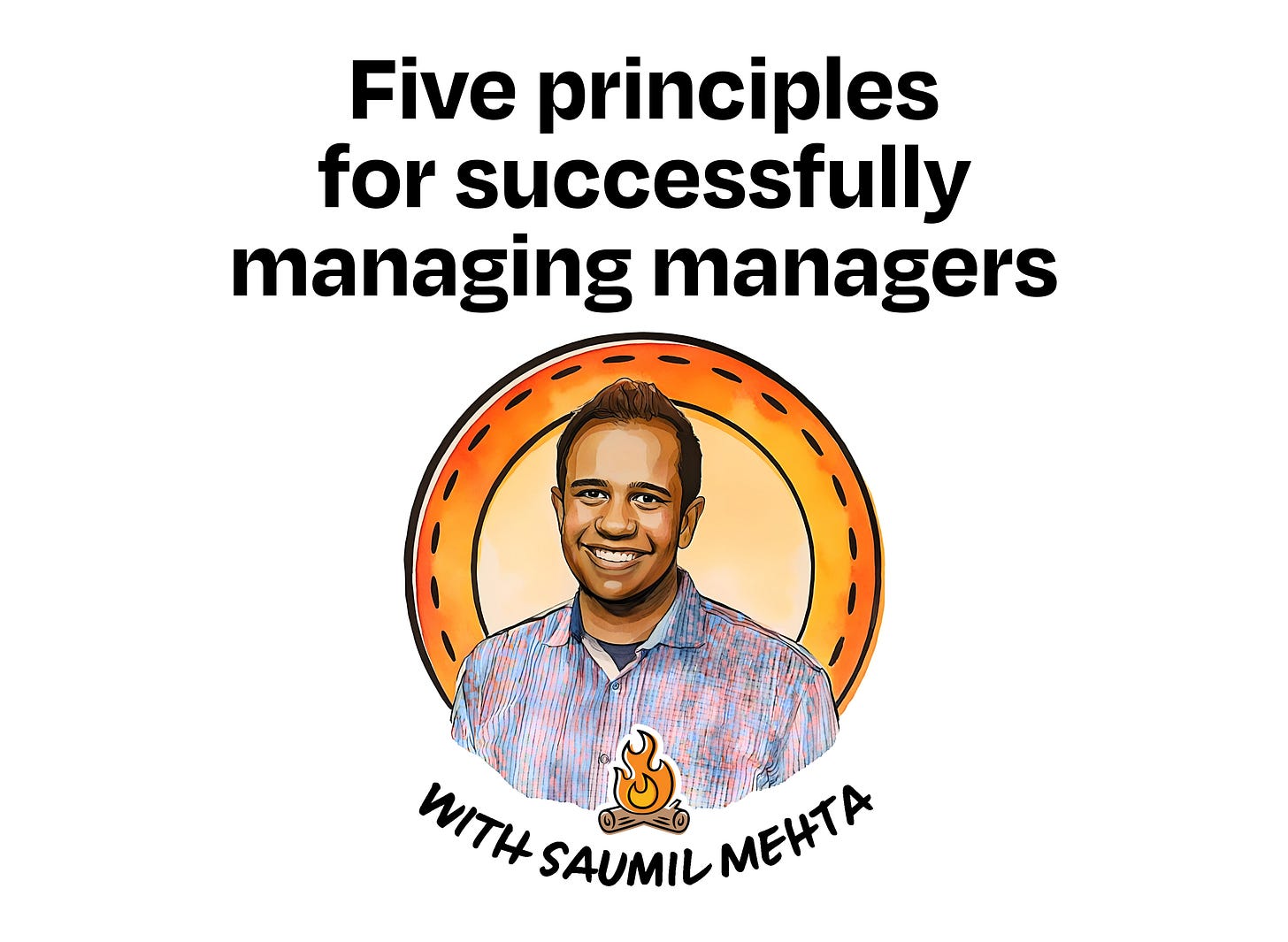


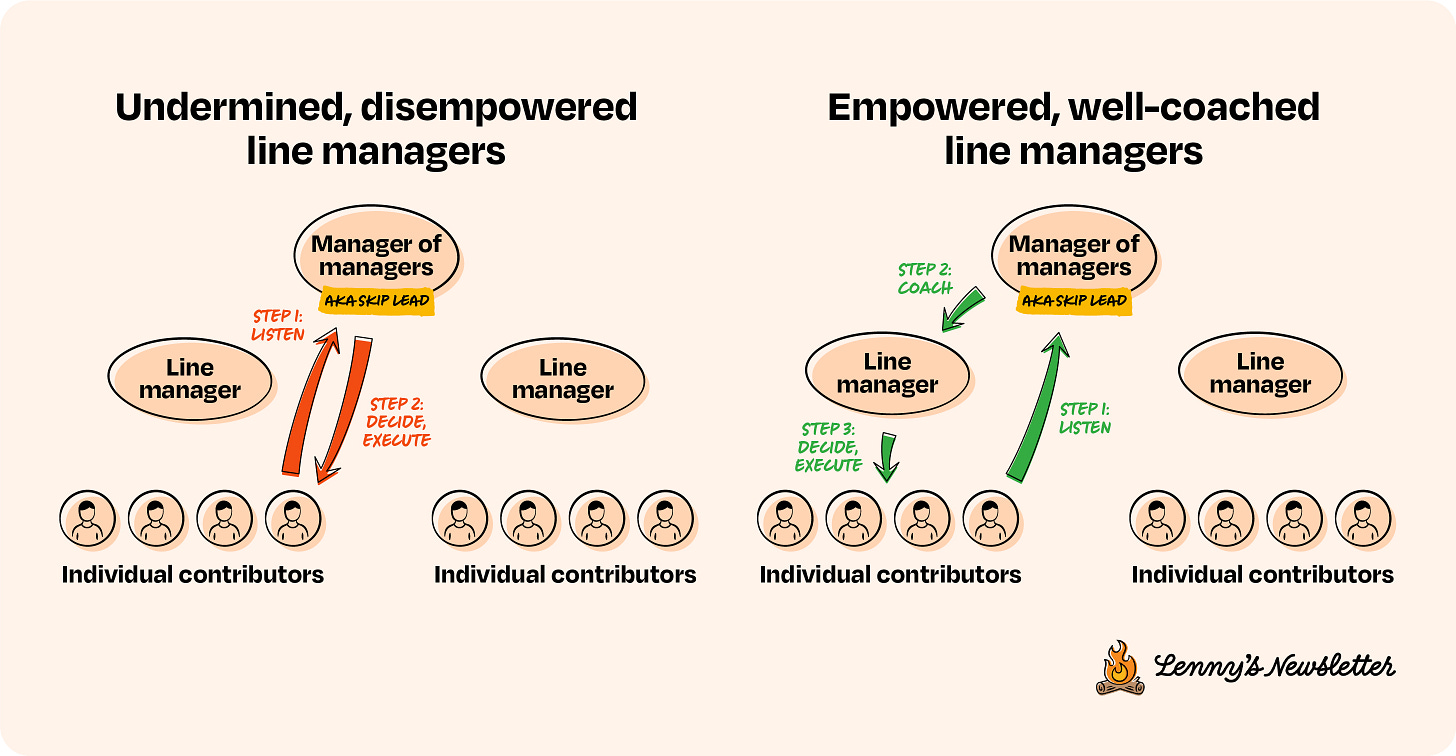
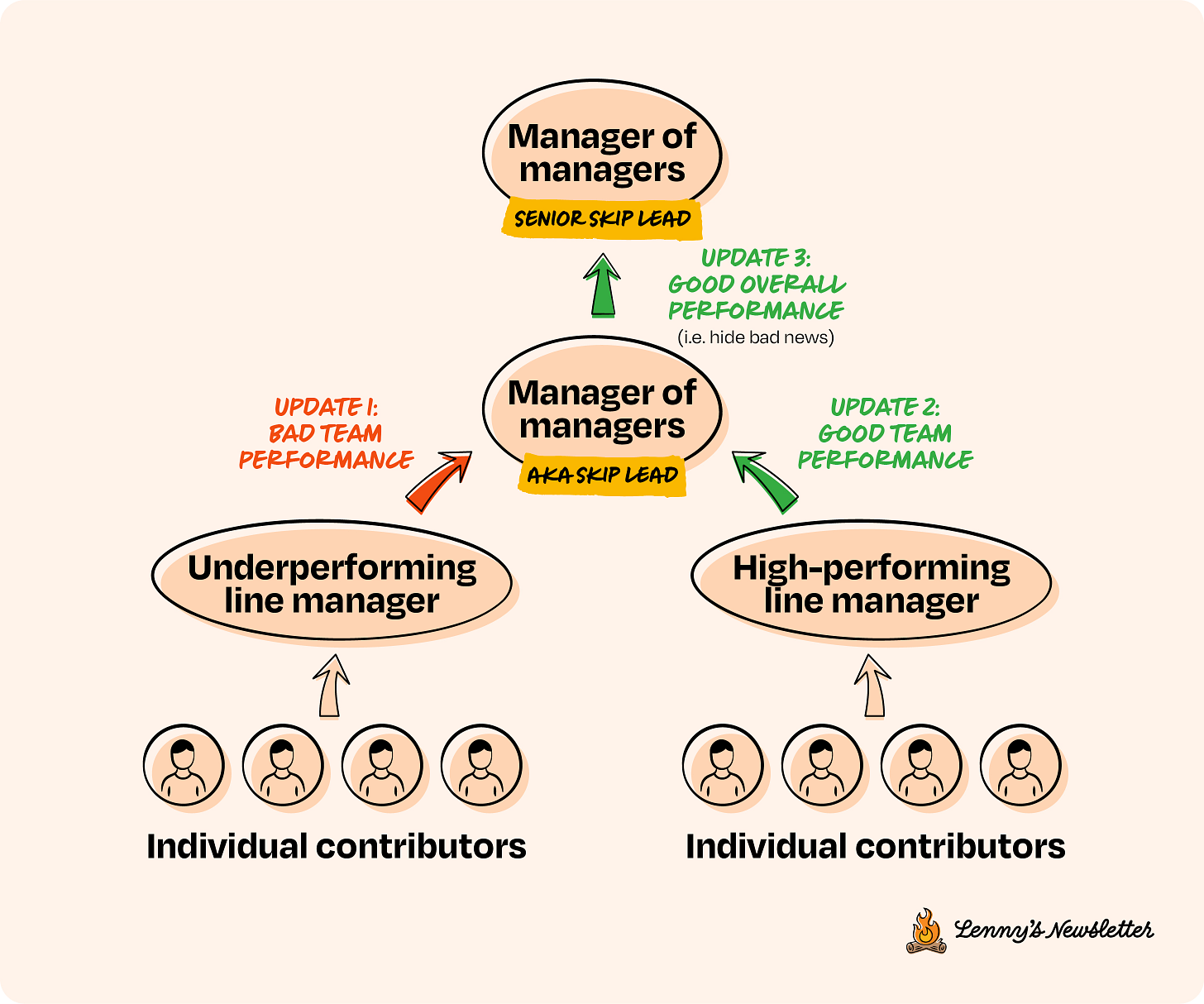
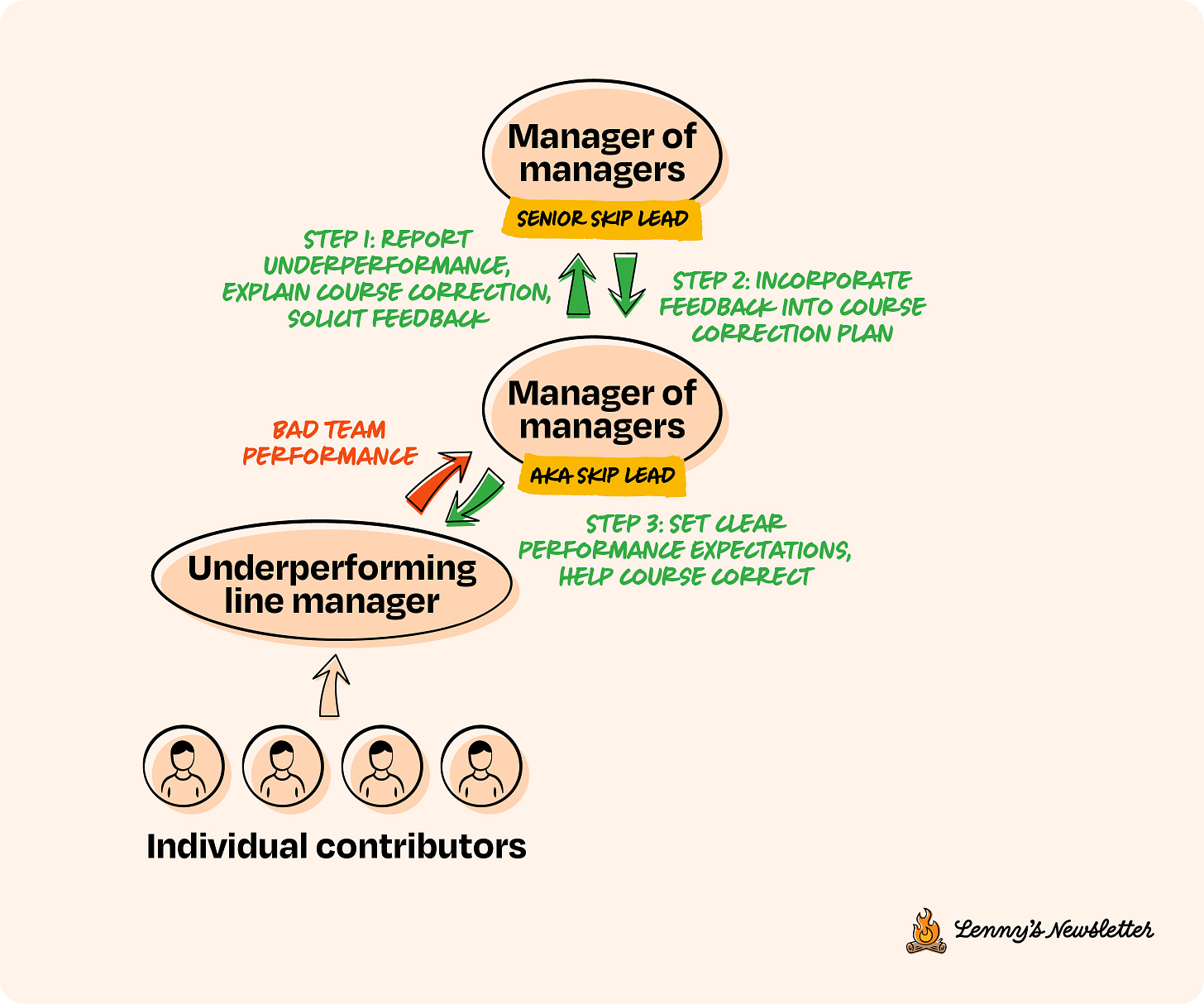
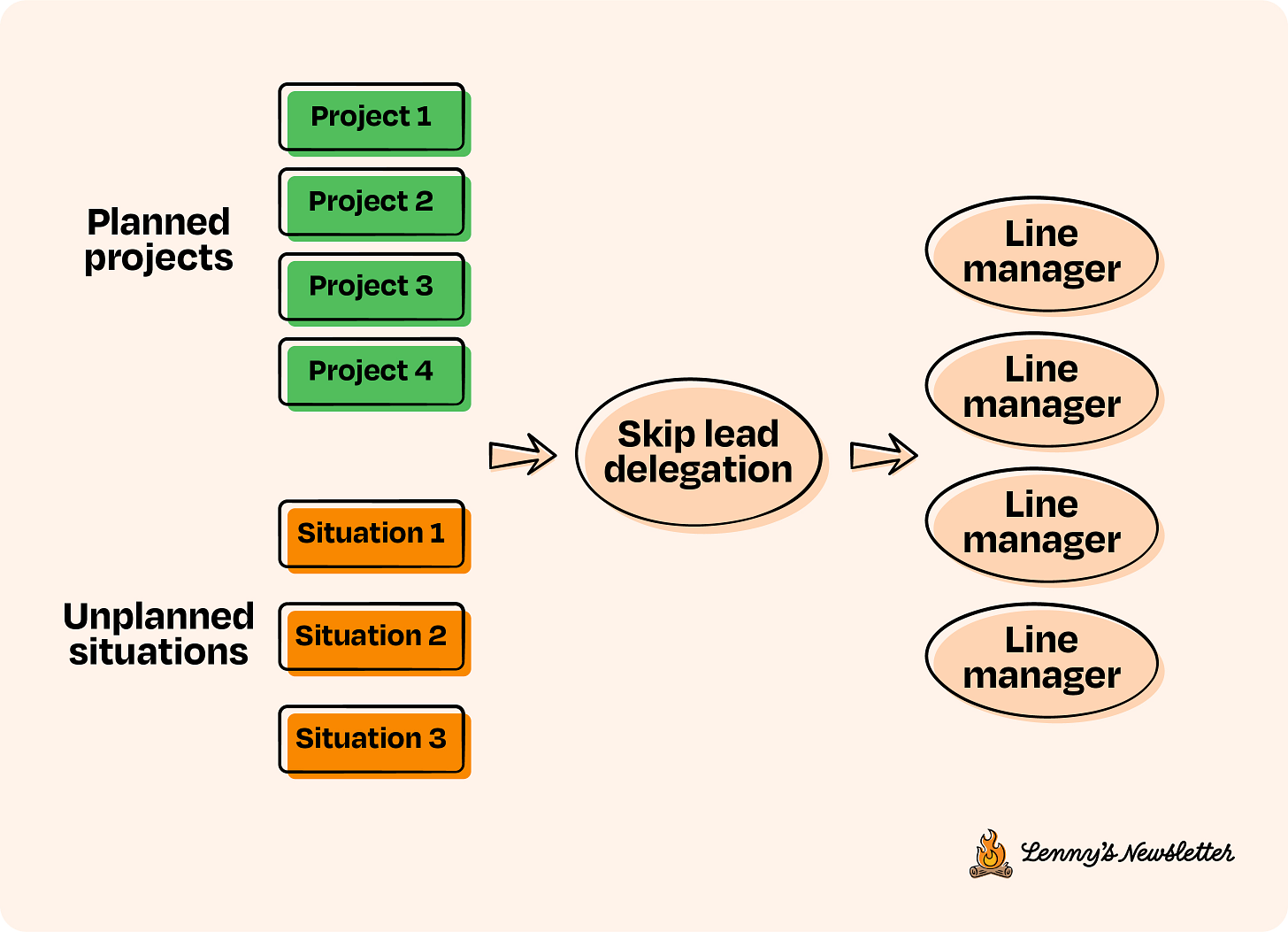
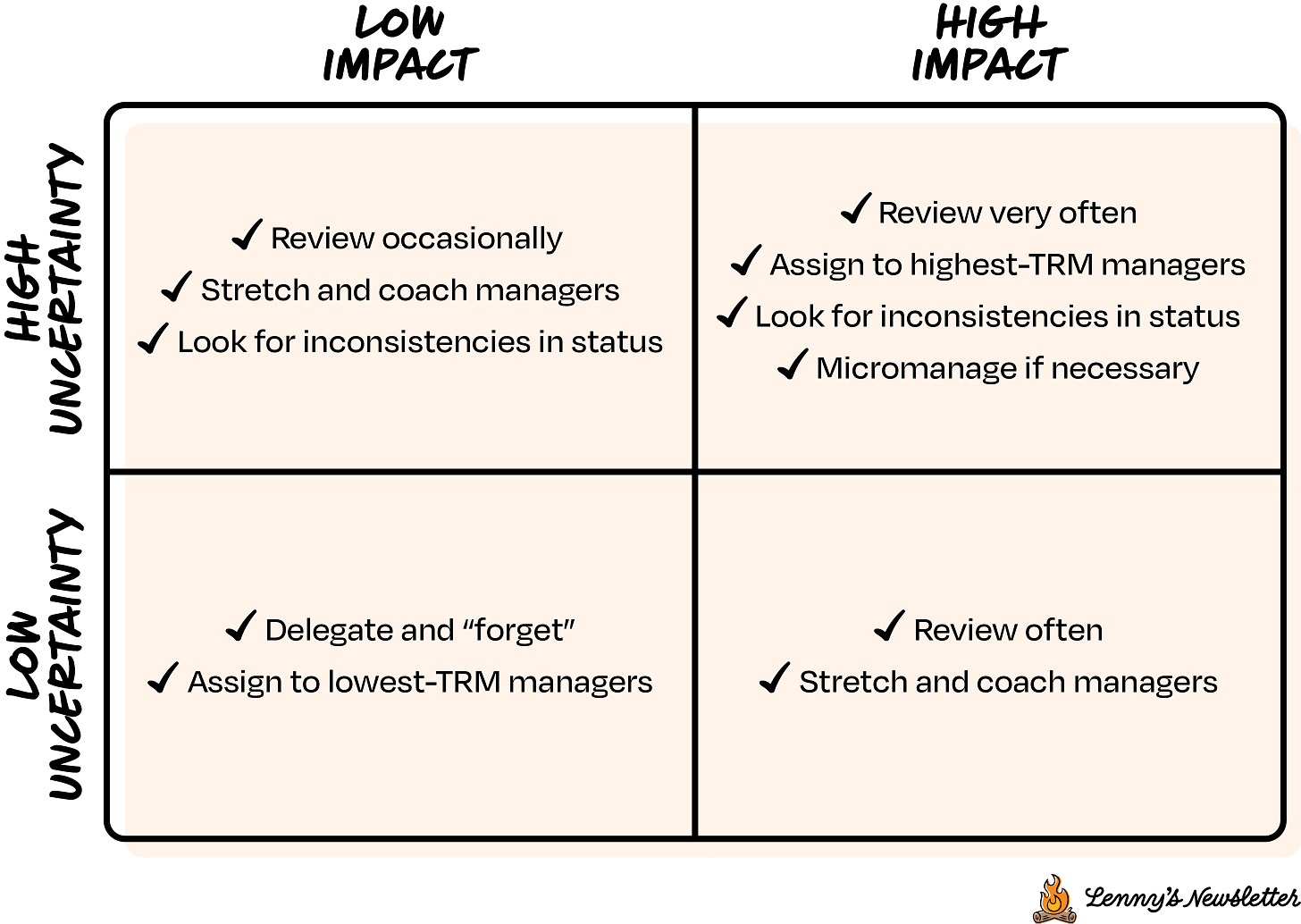


What is your framework for developing maturity in your direct team? I have also found context is so different between sitting in the mould vs breaking the mould.